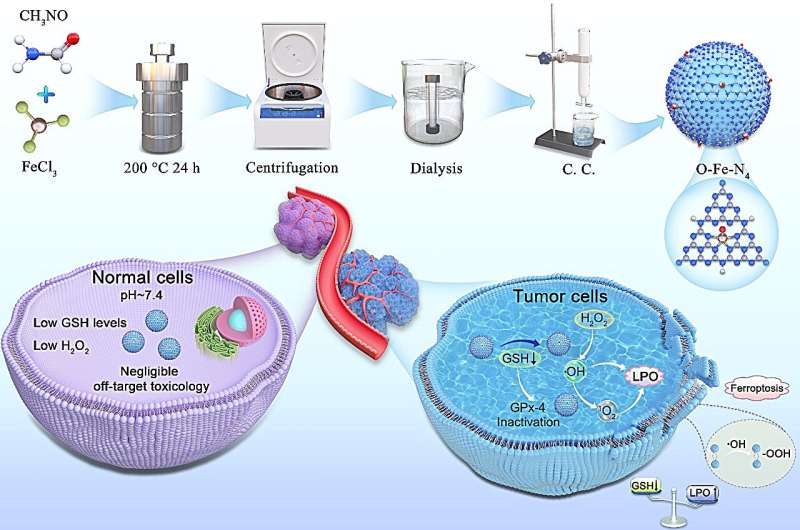This article has been reviewed according to Science X's editorial process and policies. Editors have highlighted the following attributes while ensuring the content's credibility:
fact-checked
peer-reviewed publication
trusted source
proofread
Novel single-atom nanozymes show promise for hypoxia-tolerant singlet oxygen-battery

A research group led by Prof. Wang Hui from the Hefei Institutes of Physical Science of the Chinese Academy of Sciences introduced an axial O atom-modulated Fe-N4 nanozymes for realizing efficient H2O2 Russell reaction to singlet oxygen (1O2) at hypoxic environment without external stimulus.
The study was published in Advanced Science.
1O2-elevated strategies show promise in inhibiting malignant tumor proliferation but face challenges such as inefficient and invasive external stimulation, hypoxic tumor microenvironments, and overexpressed redox species. Russell-type chemodynamic therapy (CDT) offers an oxygen-independent alternative to sensitize 1O2 generation, reducing normal tissue damage.
However, only Cu-based and Mo-based nanomaterials have been used in Russell-type CDT, as other materials are inert. Single-atom enzymes (SAEs) with tunable electronic structures and uniform active sites offer potential for designing Russell-type nano reagents, but their symmetric electron distribution often results in suboptimal catalytic performance.
In this study, researchers designed a novel single-atom enzyme (SAE) featuring an axial O atom-engineered Fe-N4 structure. Density functional theory calculations revealed that the addition of the axial O atom shifts the d-band center of the Fe-N4 site towards the Fermi level, reducing activation energy and enhancing 1O2 selectivity and production efficiency. The five-coordinated O-Fe-N4 structure ensured clear catalytic activity.
Remarkably, the O-Fe-N4 nanozyme demonstrated self-cascade enzymatic performance, with glutathione oxidase-mimicking activity and reactive oxygen species-induced performance, preventing the loss of reactive oxygen species.
Both in vivo and in vitro experiments showed that the reduction of glutathione peroxidase 4 and lipid peroxidation collectively inhibited the proliferation of triple-negative breast cancer cells.
The O-Fe-N4 SAEs not only address the inherent limitations of the 1O2-elevated tumor therapy strategy but also provide valuable insights into the advanced catalytic efficiency of Fe-N4 catalysts, according to the team.
More information: Hongji Liu et al, Axial O Atom‐Modulated Fe(III)‐N4 Sites for Enhanced Cascade Catalytic 1O2‐Induced Tumor Therapy, Advanced Science (2024). DOI: 10.1002/advs.202307254
Journal information: Advanced Science
Provided by Chinese Academy of Sciences





















